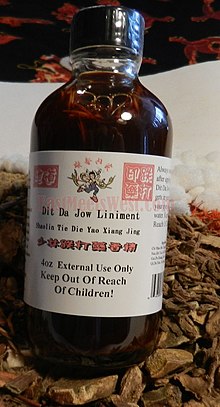Dit da jow
Dit da jow is a common Chinese liniment used as a folk remedy to supposedly heal external injuries, such as bruises or sore muscles.

| Dit da jow | |||||||||||||||
|---|---|---|---|---|---|---|---|---|---|---|---|---|---|---|---|
| Chinese | 跌打酒 | ||||||||||||||
| Literal meaning | Fall hit wine | ||||||||||||||
| |||||||||||||||
Background
There are several different recipes for Dit da jow, most of which are considered to be a "secret formula" passed down through oral and written history of traditional Chinese medicine and martial arts. Dit Da Jow is primarily used by martial artists to aid the healing of Trauma Injuries (bruises, sprains) and also iron palm training.[1]
Dit Da Jow is an analgesic liniment traditionally preferred by martial artists. Often a martial arts master blends his own mixture of aromatic herbs such as myrrh and ginseng, which when combined are believed to stimulate circulation, reduce pain and swelling, and improve healing of injuries and wounds. The tradition became known as "hit medicine". The main supposed healing function of dit da jow, according to traditional Chinese medicine, is to unblock blood stagnation and blood stasis. When one suffers a trauma type injury, qi is blocked in the meridians causing pain and swelling. Dit da jow supposedly opens up this blockage allowing the qi to flow freely allowing the injury to heal.
Dit da jow is made from herbs put in a glass or polyethylene terephthalate plastic jar and mixed with an alcohol such as vodka or gin. Centuries ago, Dit da jow was made by combining the herbs in a clay vessel and adding rice wine, then burying the vessel in the ground for months or even years; it was believed that the longer the herbs sat in the alcohol, the stronger the solution became.
Typical ingredients
The herbs and other ingredients are typically coarse-ground, then steeped in alcohol (vodka or rice wine is common), sometimes with heat, and then aged.
Traditional ingredients
Traditional recipes may include:
- baji tian (morinda root)
- baibu (stemona)
- baidou kou (white cardamom)
- baihuashe (pit viper)
- baiji zi (mustard seed)
- baishao (white peony, Paeonia lactiflora)
- baizhi (white angelica)
- banxia (Pinellia)
- cangzhu (black Atractylodes)
- caowu (Aconitum kusnezoffii, a member of the large aconitum genus)
- cheqian zi (cooking plantain seed)
- chenpi (aged citrus peel)
- chenxiang (Aquilaria wood)
- chishao (Paeonia lactiflora, red peony)
- chuanpo shi (Maclura tricuspidata)
- chuanshan long (Dioscorea polystachya, Chinese yam)
- chuanwu (Aconitum carmichaelii)
- chuanxiong (ligusticum root)
- dahuang (rhubarb)
- danshen (salvia)
- danggui (angelica root)
- danggui wei (angelica root tail)
- digupi (lycium bark)
- dingxiang (clove bud)
- duhuo (angelica pub)
- duzhong (eucommia bark)
- ezhu (Curcuma zedoaria)
- fangfeng (siler root)
- fuhai shi (pumice)
- fuling (perenniporia)
- fupen zi (raspberry fruit)
- fuzi (Aconitum)
- gancao (glycyrrhiza uralensis’')
- ganjiang (ginger root)
- gaoliang jiang (galangal rhizome)
- gegen (kudzu root)
- gouqi zi (lycium berry)
- gusuibu (drynaria)
- guileren (trichosanthes seed)
- guizhi (cinnamon)
- haifeng teng (kadsura stem)
- hong hua (carthamus/safflower)
- hua jiao (prickly ash pepper or sichuan pepper(?))
- huang bai (phellodendron)
- huang qin (skullcap)
- ji xue teng (millettia)
- jiang huang (turmeric)
- jiang xiang (dalbergia rosewood)
- jie geng (platycodon)
- jing jie (schizonepeta)
- kuan jin teng (tinospora cordifolia stem)
- li lu (veratrum)
- liu huang (sulfur)
- liu ji nu (artemisia)
- long gu (dragon bone)
- lu lu tong (liquidambar fruit)
- luo shi teng (star jasmine vine)
- ma huang (ephedra) or gui zhi (cinnamon)
- menthol
- mo yao (myrrh)
- mu dan pi (mountain peony)
- mu gua (quince fruit)
- mu tong (akebia)
- mu xiang (Saussurea costus)
- niu xi (achyranthes)
- pu gong ying (dandelion)
- pu huang (cattail pollen)
- qian nian jian (homalomena)
- qiang huo (notopterygium incisum)
- qin jian (gentian root)
- qing pi (citrus peel)
- rou cong rong (cistanche)
- rou gui (cinnamon bark)
- ru xiang (frankincense)
- san leng (sparganium or bur-reed)
- san qi (panax pseudoginseng)
- shan zhu yu (cornus berry)
- she chuang zi (cnidium seed)
- sheng di huang (rehmannia)
- shu di huang (cooked Rehmannia root)
- song jie (pine branch)
- su mu (Caesalpinia sappan)
- tao ren (peach kernel)
- tian ma (Gastrodia)
- tian nan xing (Arisaema)
- {{transl|zh|italic=no|tubie chong}] ('Eupolyphaga sinensis, dried cockroach)
- tu si zi (cuscuta seed)
- wei ling xian (clematis root)
- wu jia pi (Eleutherococcus)
- wu ling zhi (mouse droppings)
- wu wei zi (Euodia fruit)
- xi xing (wild ginger)
- xiang fu (cyperus nut)
- xu duan (dipsacus root)
- xue jie (dragon's blood)
- yan hu suo (Corydalis)
- yu jin (turmeric tuber)
- ze lan (Lycopus lucidus)
- zhang nao (camphor)
- zhi ke (bitter orange peel)
- zi ran tong (pyrite)
- zi su ye (perilla leaf)
- zi wan (Callistephus root)
Westernized recipe ingredients
Some recipes instead use ingredients more readily available, such as:
- Arnica blossoms
- Blessed thistle
- Cinnamon bark
- Comfrey
- Ginger root
- Goldenseal root
- Myrrh
- Pseudoginseng
- Rhubarb root
- Sarsaparilla root
- Witch-hazel
References
- East. "Dit Da Jow is not primarily for Martial artists". East Meets West. Retrieved 15 December 2020.